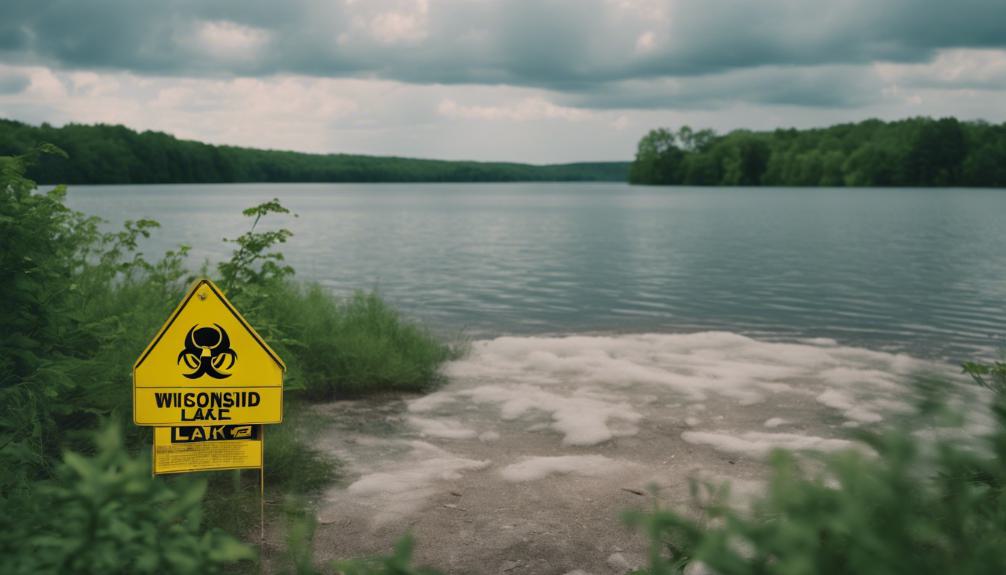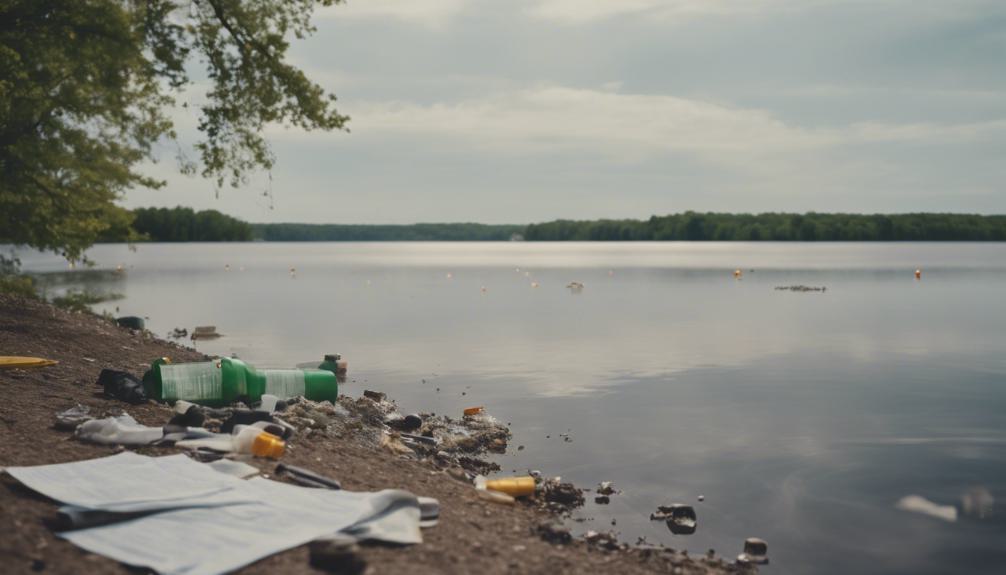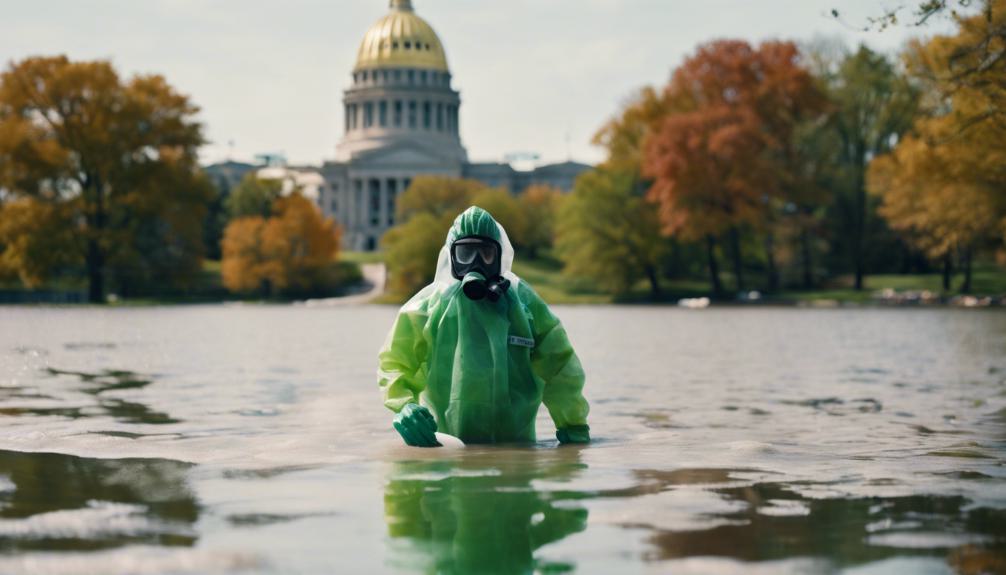Wisconsin Battles Toxic Foam Crisis
In the heart of Wisconsin, an environmental predicament unfolds as the state grapples with the insidious presence of PFAS contamination, casting a shadow over its pristine waterways and jeopardizing public health. This crisis, emanating from everyday products and industrial activities, has propelled the Wisconsin Department of Natural Resources into a pivotal role, tasked with forging a path towards mitigating the risks associated with these toxic substances. As the debate over tightening safety standards intensifies, the implications of such measures not only for Wisconsin but also as a precedent for national policy loom large. This unfolding scenario beckons a closer examination of the intricate balance between industrial progress and environmental stewardship.
Key Takeaways
- PFAS chemicals in Wisconsin wells prompt state to consider new safety standards.
- Proposed rule aims to restrict PFAS use amid public health concerns.
- Public hearing by Wisconsin Department of Natural Resources addresses widespread contamination.
- Wisconsin joins other states in implementing regulations to combat PFAS environmental impact.
Background of PFAS Contamination

Perfluoroalkyl and polyfluoroalkyl substances (PFAS), introduced into the manufacturing industry in the 1940s, have become a pervasive environmental pollutant with significant implications for public health and ecosystems. These synthetic chemicals, utilized for their water and oil repellant properties, are found in a myriad of consumer products, ranging from non-stick cookware to waterproof clothing and firefighting foams. The durability of PFAS, which contributes to their widespread use, also renders them resistant to natural degradation processes, leading to their accumulation in the environment. The presence of PFAS in soil and waterways has raised concerns regarding their potential to contaminate drinking water supplies. Research has linked prolonged PFAS exposure to a host of adverse health outcomes, including liver damage, cancer, and developmental issues, underscoring the urgency of addressing PFAS contamination for the well-being of communities and the preservation of natural habitats.
Wisconsin's Toxic Foam Crisis

Wisconsin is grappling with a severe environmental crisis as toxic foam, heavily contaminated with PFAS chemicals, increasingly pollutes its waterways. The state faces a challenging challenge in addressing the environmental impact of these persistent chemicals, which have been detected across a broad spectrum of water bodies. Efforts to combat the spread of this toxic foam are underway, highlighting the urgent need for thorough solutions. Community members and local governments are calling for immediate action to mitigate the contamination and protect Wisconsin's natural resources. State officials, in response, are considering the implementation of new safety standards and have proposed rules to restrict PFAS use. This crisis underscores the critical importance of environmental stewardship and the collective responsibility to safeguard water quality for future generations.
Public Health Risks Identified

Amid the ongoing efforts to address the environmental impact of PFAS, public health officials have identified significant risks associated with exposure to these chemicals. Among these are the potential for liver damage, increased cholesterol levels, and a higher risk of cancer, particularly in communities close to contaminated sites. These findings underscore the urgent need for individuals and communities to take preventive measures. They are encouraged to access clean water sources and engage in regular health screenings. Public health campaigns are pivotal in disseminating information on the risks of PFAS and guiding communities on how to reduce exposure. The collaboration between health professionals, environmental agencies, and the public is critical in mitigating these health risks and safeguarding the well-being of affected populations.
State Safety Standards Debate

As states grapple with the pervasive issue of PFAS contamination, discussions around the implementation of thorough safety standards have taken center stage in legislative debates. In Wisconsin, officials are deliberating over new regulations that aim to mitigate the impact of these harmful chemicals on public health and the environment. The proposed measures, including setting limits for PFAS concentrations in water sources, reflect a growing awareness of the risks associated with long-term exposure to these substances. Advocates for stronger safety protocols argue that such standards are essential for safeguarding communities and preserving natural resources. The debate underscores the urgent need for thorough strategies that address the complex challenges posed by PFAS contamination, emphasizing a commitment to public welfare and environmental stewardship.
Public Hearing Insights

Numerous stakeholders, including residents affected by PFAS contamination, environmental advocates, and industry representatives, convened at the public hearing hosted by the Wisconsin Department of Natural Resources to voice their concerns and suggestions regarding the proposed PFAS regulations. The discourse primarily centered around the health implications of PFAS exposure, with affected community members sharing personal narratives to underscore the urgency of rigorous regulatory measures. Environmental groups advocated for thorough restrictions to mitigate further contamination, emphasizing the need for proactive rather than reactive approaches to environmental stewardship. Meanwhile, industry voices called for balanced regulations that consider economic impacts without compromising public health. The hearing underscored a collective aspiration for solutions that protect both the environment and the welfare of Wisconsin's residents.
National PFAS Usage Overview

PFAS chemicals, introduced into the manufacturing industry in the 1940s, are now pervasive in various consumer products and industrial applications across the nation. These substances, recognized for their durability and resistance to water, oil, and heat, have found widespread use in non-stick cookware, water-repellent clothing, stain-resistant fabrics, and firefighting foams. Despite their functional benefits, the ubiquity of PFAS raises concerns due to their persistence in the environment and potential accumulation in human bodies over time. As awareness grows, communities and industries are grappling with the challenge of balancing the benefits of PFAS in modern conveniences against the imperative to safeguard public health and the environment. Efforts to understand and regulate the use of PFAS underscore a collective commitment to addressing this complex issue.
Adverse Environmental Impact

The introduction of PFAS chemicals into the environment has led to significant contamination of soil and waterways, posing a persistent threat to ecosystems and human health. These synthetic chemicals, once hailed for their resistance to heat, oil, and water, have now become a source of widespread environmental degradation. The adverse impact is not confined to the natural world alone; it extends to communities that rely on these ecosystems for drinking water, agriculture, and recreation. The infiltration of PFAS into the environment disrupts aquatic life, diminishes biodiversity, and compromises the quality of water sources. As stewards of the environment, it's imperative to acknowledge the gravity of this issue and work collectively towards mitigating the effects of PFAS contamination, safeguarding both our natural habitats and the well-being of future generations.
Regulatory Measures in Wisconsin

In response to escalating concerns over water safety, Wisconsin officials are advancing regulatory measures to limit the presence of PFAS chemicals in the state's water supply. Acknowledging the adverse health effects linked to these substances, the state is considering the implementation of new safety standards aimed at securing its residents. A public hearing conducted by the Wisconsin Department of Natural Resources underscored the gravity of the situation, leading to the proposition of a rule to restrict PFAS usage. This initiative represents a significant step towards safeguarding public health and the environment from the pernicious impact of these chemicals. By addressing the source of contamination, Wisconsin aims to prevent further pollution and secure the well-being of its communities.
Comparative State Actions

Building on Wisconsin's efforts to regulate PFAS chemicals, several states across the nation are actively implementing measures to address the contamination and its impact on public health. States like Michigan, Minnesota, New York, and Maine have taken significant steps to curtail the presence of these hazardous substances in the environment. Michigan has set rigorous standards for PFAS in drinking water, aiming to protect its residents from potential health risks. Similarly, Maine has committed to an ambitious goal of banning PFAS by 2030, reflecting a strong dedication to safeguarding environmental and public health. New York, on the other hand, is focusing on establishing clear guidelines for allowable PFAS concentrations, ensuring water safety for its communities. These collective actions underscore a growing recognition of the need for stringent regulations to combat PFAS contamination and protect public welfare.
Federal Strategic Roadmap

Responding to the nationwide concern over PFAS contamination, the U.S. Environmental Protection Agency (EPA) has revealed a Strategic Roadmap aimed at tackling the pervasive issue through a series of stringent measures and guidelines. This initiative reflects the EPA's commitment to safeguarding public health and the environment from the adverse effects of these persistent chemicals. By implementing new reporting requirements, restrictions, and enforceable drinking water limits, the EPA endeavors to reduce PFAS exposure and mitigate its impact. Moreover, the roadmap outlines plans for increased monitoring, data collection, and research, laying a robust technical foundation for extensive PFAS analysis. This strategic approach demonstrates the federal government's dedication to addressing environmental challenges and protecting communities, emphasizing a proactive stance in the face of emerging contaminants.
Monitoring and Future Steps
Following the establishment of the Strategic Roadmap by the EPA, attention now turns to the implementation of monitoring systems and the planning of future steps to combat PFAS contamination effectively. The focus is on creating a robust framework that not only identifies current contamination levels but also prevents future incidences. This involves deploying advanced technologies for detecting PFAS in water sources, soil, and the air, thereby safeguarding public health and the environment. Additionally, the initiative aims to foster collaboration among federal, state, and local agencies to make a unified response. Educating the public on the risks associated with PFAS and measures to minimize exposure is also a critical component. Together, these efforts signify a thorough approach to addressing the PFAS crisis, emphasizing prevention, transparency, and accountability.
Frequently Asked Questions
How Can Residents in Affected Areas Test Their Own Water Supply for PFAS Contamination?
Residents concerned about PFAS contamination in their water supply can initiate testing by contacting local environmental agencies or health departments for recommendations on certified testing services. It is essential to use laboratories that are accredited to test for PFAS to guarantee accurate results. Additionally, individuals should inquire about the specific PFAS compounds the lab can detect and follow the provided instructions carefully to collect a valid water sample for analysis.
Are There Any Local Community Support Groups or Resources Available for Residents Dealing With Pfas-Related Health Issues?
For residents grappling with PFAS-related health concerns, numerous local community support groups and resources are available to provide assistance and guidance. These entities offer critical information, emotional support, and advocacy services to individuals affected by PFAS contamination. Engaging with these groups can empower residents to navigate the complexities of managing potential health risks and advocating for cleaner, safer environmental standards. Residents are encouraged to seek out these resources to bolster their support network and access reliable information.
What Specific Types of Consumer Products Should Individuals Avoid to Reduce Their Exposure to Pfas?
To mitigate exposure to PFAS, a class of chemicals linked to adverse health effects, individuals should be cautious about products they use daily. For example, non-stick cookware, often praised for its convenience, can release PFAS into food during cooking. Opting for alternatives such as stainless steel or cast iron can greatly reduce PFAS exposure. This proactive approach serves not only personal health but also contributes to broader environmental protection efforts.
How Do the Health Impacts of PFAS Exposure Differ Between Adults, Children, and Pets?
The health impacts of PFAS exposure can vary greatly between adults, children, and pets, primarily due to differences in metabolism, body weight, and developmental stages. Adults may experience effects such as liver damage, increased cholesterol levels, and cancer. Children, being more vulnerable, could suffer from developmental delays and immune system impacts. Pets, particularly dogs, might face increased risks of liver and thyroid disease. Monitoring and reducing PFAS exposure is essential for all.
Can Homeowners Take Legal Action Against Companies Responsible for PFAS Contamination in Their Community?
Homeowners impacted by PFAS contamination may explore legal avenues against responsible companies. Such actions can seek compensation for property damage, health impacts, and other losses. It's important to consult with an attorney experienced in environmental law to understand the specifics of one's case and the likelihood of a successful outcome. Legal precedents and regulations surrounding PFAS contamination are evolving, making expert guidance essential in managing these complex legal challenges.
Conclusion
To conclude, Wisconsin wades through tumultuous tides as it tackles the toxic turmoil of PFAS contamination. Swift, strategic steps by state stewards, spurred by significant societal and scientific scrutiny, signify a steadfast commitment to curtailing this chemical crisis. Through tailored regulatory reforms and rigorous remediation requirements, Wisconsin, alongside other states and supported by federal frameworks, forges forward, fervently focusing on a future where waterways and well-being are wholesomely safeguarded against pernicious pollutants.

This post has been generated by AI and was not reviewed by editors. This is Not legal advice. Please consult with an attorney.

